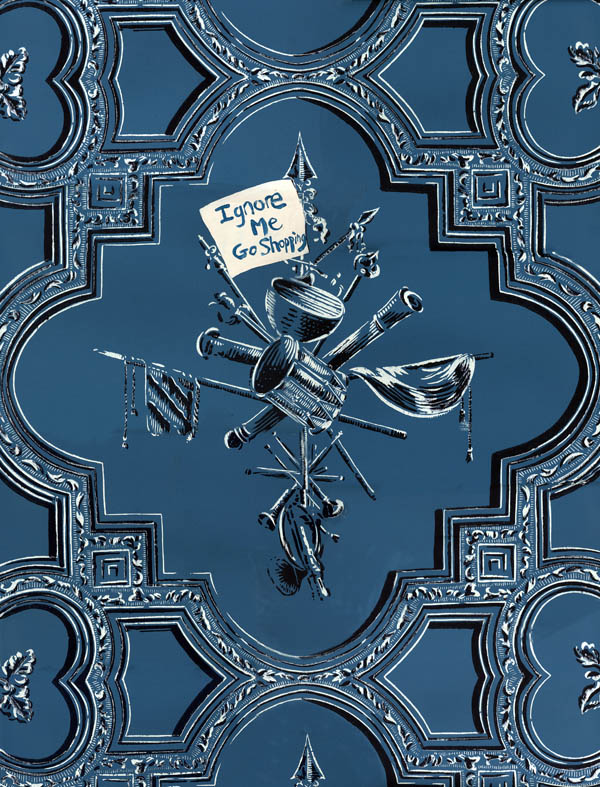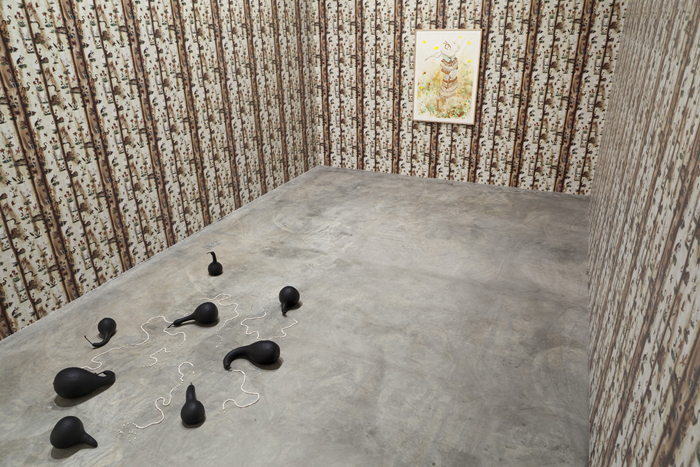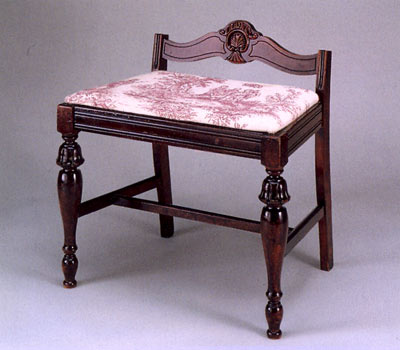 WE THE PEOPLE, a new solo project for Expo Chicago/2012 at the Navy Pier, September 19 – 24, 2012.
Lauren Adams: We the People is organized by the Contemporary Art Museum St. Louis (CAM) and curated by Kelly Shindler, Assistant Curator.
Lauren Adams’s work addresses historical issues of colonialism—the system by which the people of one territory establish systems of authority or control over people in another territory—and industrialization to demonstrate how they inform our present-day reality. Working in a variety of media from painting and drawing to textiles and printmaking, she repurposes centuries-old imagery to explore the relationship between labor and the production of material goods. Adams uses specific images, symbols, and situations from these histories to suggest how they play a significant role in the balance of power between social classes, nations, and ethnicities today.
We the People is an interactive installation in which the artist has painted slogans from recent Occupy Wall Street and Tea Party protests into reproduced Revolutionary War-era wallpaper. The pattern, entitled “General Samuel McClellan,” features a repeated image of various everyday objects from the 18th-century. Extracted and abstracted from its original context, the protest language visible on the wallpaper functions as a generalized call to action. Visitors to CAM’s booth can record their own “protest” on a unique ceramic plate to be displayed during the fair. A custom-designed tea towel made exclusively for Expo Chicago both advertises the project and is exchanged with visitors in return for their contributions.
Adams is also exhibiting new work in a solo exhibition, Hoard, in CAM’s Front Room gallery from September 7 – October 14, 2012 (3750 Washington Blvd., St. Louis, MO 63108).
Above text by Kelly Shindler
READ the EXPO Chicago recap by Chief Curator Dominic Molon.
SEE reviews and exhibition photography at these website links:
Artslant, by Sarah Hamilton
New City Chicago, by Pedro Velez
Hyperallergic, by Philip A. Hartigan
World Socialist Web Site, by Jeff Lusanne
Univision Chicago (photo)
Art in America, The Scene (photo)
Special thanks to Jake Peterson + Arsenal Studios, Bryan Reckamp (tea towel designer), Clare Britt (install and photography), Eli Samuels (install crew), Kelly Shindler and Dominic Molon and the rest of the staff at CAMSTL including David Smith (install crew), as well as Spoonflower.]]>
WE THE PEOPLE, a new solo project for Expo Chicago/2012 at the Navy Pier, September 19 – 24, 2012.
Lauren Adams: We the People is organized by the Contemporary Art Museum St. Louis (CAM) and curated by Kelly Shindler, Assistant Curator.
Lauren Adams’s work addresses historical issues of colonialism—the system by which the people of one territory establish systems of authority or control over people in another territory—and industrialization to demonstrate how they inform our present-day reality. Working in a variety of media from painting and drawing to textiles and printmaking, she repurposes centuries-old imagery to explore the relationship between labor and the production of material goods. Adams uses specific images, symbols, and situations from these histories to suggest how they play a significant role in the balance of power between social classes, nations, and ethnicities today.
We the People is an interactive installation in which the artist has painted slogans from recent Occupy Wall Street and Tea Party protests into reproduced Revolutionary War-era wallpaper. The pattern, entitled “General Samuel McClellan,” features a repeated image of various everyday objects from the 18th-century. Extracted and abstracted from its original context, the protest language visible on the wallpaper functions as a generalized call to action. Visitors to CAM’s booth can record their own “protest” on a unique ceramic plate to be displayed during the fair. A custom-designed tea towel made exclusively for Expo Chicago both advertises the project and is exchanged with visitors in return for their contributions.
Adams is also exhibiting new work in a solo exhibition, Hoard, in CAM’s Front Room gallery from September 7 – October 14, 2012 (3750 Washington Blvd., St. Louis, MO 63108).
Above text by Kelly Shindler
READ the EXPO Chicago recap by Chief Curator Dominic Molon.
SEE reviews and exhibition photography at these website links:
Artslant, by Sarah Hamilton
New City Chicago, by Pedro Velez
Hyperallergic, by Philip A. Hartigan
World Socialist Web Site, by Jeff Lusanne
Univision Chicago (photo)
Art in America, The Scene (photo)
Special thanks to Jake Peterson + Arsenal Studios, Bryan Reckamp (tea towel designer), Clare Britt (install and photography), Eli Samuels (install crew), Kelly Shindler and Dominic Molon and the rest of the staff at CAMSTL including David Smith (install crew), as well as Spoonflower.]]>
Month: September 2012
Hoard, Solo Exhibition at Front Room, Contemporary Art Museum, St. Louis
 Hoard at CAMSTL, opening September 7 and ongoing through October 14, 2012.
Curated by Kelly Shindler
Mentioned in Temporary Art Review by Laura Barone in an article about Leslie Hewitt’s concurrent show at CAM, Sudden Glare of the Sun.
Lauren Adams: Hoard
Lauren Adams mines the histories of early exploration, colonialism, and industrialization to make new and surprising connections to contemporary sociopolitical issues. Employing a variety of media from paintings and drawings to textiles and printmaking, she engages obscure imagery and phenomena to explore the relationship between labor and material culture. Purposely anachronistic, her objects and installations are also deeply relevant for suggesting how we understand power dynamics today.
In the Front Room, Adams presents a multi-part installation that furthers her research into early encounters between the leaders of Elizabethan England and the North American “New World” in the late 16th and early 17th centuries. On the walls of the gallery, she has installed custom wallpaper titled Spectacle of Hardwick Hall (2012). Drawn by hand and reproduced digitally, the design features symbols found in the large portrait of Queen Elizabeth I (1533-1603) that hangs in the 16th-century Hardwick Hall estate in Derbyshire, England. In the painting (c. 1592; attributed to Nicholas Hilliard, 1547-1619), the queen wears an unusual, voluminous gown embroidered with images of flora and fauna native to the English colonies as well as imagined creatures, such as serpents and monsters. Demonstrating the breadth and depth of her power, the queen’s costume literally contains a world within it. This bringing together of the foreign with the fantastical suggests an exoticization of the colonies as a sensuous albeit perilous “other.” Adams’s translation of this imagery into a repetitive wallpaper pattern calls attention to their peculiarity while neutralizing their potency as royal propaganda.
Also featured in the installation is a large gouache painting titled The Lost Colony (2012). Whereas Spectacle of Hardwick Hall isolates a particular feature of Elizabeth’s dress as a commentary on the riches of empire, this painting conflates the aesthetics and behavior of occupier and occupied. Adams has painted an image of a dancing Algonquin Indian, which she modeled on a 16th century print by Theodor de Bry (1528-1598) that was inspired by John White’s (c. 1540-1593) watercolors of Algonquin Indians in Adams’s home state of North Carolina. The male figure wears a feather headdress and assumes an active pose, brandishing an arrow in hand. His elongated body is adorned with layers of various Elizabethan-era collars of various textures and styles. These have the effect of appearing to civilize, feminize, and also constrict the figure, literally strangling him in fashion. In effect, the painting hybridizes signifiers from both cultures, illustrating the ultimately unsustainable relationships between British and Native American peoples.
The final component of the installation is Bad Seed (2012), an arrangement of hollowed-out, painted-black gourds, interspersed with several strands of freshwater pearls on the gallery floor. Indigenous to the New World as sustenance, here the gourds assume an ornamental function in the same way that pumpkins and Indian corn have evolved from bumper crops to autumnal ornaments. Adams treats the pearls in a similarly inverse manner to producing wallpaper from the pattern of Queen Elizabeth’s gown; both gestures reduce luxurious high fashion to interior decoration. On a deeper level, the stark contrast between the black gourds and the white pearls references the charged racial and ethnic dynamics instantiated in the New World and that have persisted throughout American history.
The title of the exhibition, “Hoard,” refers to the aggregation of wealth and resources by the colonizers of the New World as well as the larger notion of creating an iconographic taxonomy of empire. Through Adams’s appropriation and transformation of colonial imagery — originally intended to denote power and grandeur — into decorative, often fabricated designs, Hoard demonstrates the deterioration of meaning that can accompany the accumulation of things — or, in the case of pre-colonial America, that of people and places as well. Adams collages these abstracted elements together, creating charged absurdities that reflect centuries of inequity. Simultaneously visually alluring and symbolically complex, the works in Hoard remind us how the legacies of the New World’s founding remain both embedded and contested in everyday life.
Adams will present related work in a satellite solo exhibition, We the People, at the inaugural ExpoChicago art fair from September 19-23, 2012. Navy Pier, 600 East Grand Avenue, Chicago, IL, 60611.
Lauren Adams (American, b. 1979) lives and works in Baltimore, Maryland, where she is a full-time faculty member at the Maryland Institute College of Art. She has had recent solo exhibitions at Back Lane West, Cornwall, UK (2012); Conner Contemporary, Washington, D.C. (2011); Luminary Center for the Arts, St. Louis (2011); and Royal NoneSuch Gallery, Oakland, California (2010). Her work has been featured in group exhibitions including: Nymans House and Gardens, Sussex, UL (2012); Cameron Art Museum, Wilmington, North Carolina (2012), Southeastern Center for Contemporary Art, Winston-Salem, North Carolina (2011); Purdue University, Indiana (2011); St. Cecelia’s, Brooklyn, New York (2010); CUE Foundation, New York (2008); Mattress Factory, Pittsburgh, PA (2008); and the Andy Warhol Museum of Art, Pittsburgh, PA (2005); among many others. She received her MFA from Carnegie Mellon University (2007) and has attended several artist residencies, including the Cité Internationale des Arts, Paris (2010); Skowhegan School of Painting and Sculpture (2009); and the Jentel Artist Residency Program, Banner, Wyoming (2008).
–Above text by Kelly Shindler]]>
Hoard at CAMSTL, opening September 7 and ongoing through October 14, 2012.
Curated by Kelly Shindler
Mentioned in Temporary Art Review by Laura Barone in an article about Leslie Hewitt’s concurrent show at CAM, Sudden Glare of the Sun.
Lauren Adams: Hoard
Lauren Adams mines the histories of early exploration, colonialism, and industrialization to make new and surprising connections to contemporary sociopolitical issues. Employing a variety of media from paintings and drawings to textiles and printmaking, she engages obscure imagery and phenomena to explore the relationship between labor and material culture. Purposely anachronistic, her objects and installations are also deeply relevant for suggesting how we understand power dynamics today.
In the Front Room, Adams presents a multi-part installation that furthers her research into early encounters between the leaders of Elizabethan England and the North American “New World” in the late 16th and early 17th centuries. On the walls of the gallery, she has installed custom wallpaper titled Spectacle of Hardwick Hall (2012). Drawn by hand and reproduced digitally, the design features symbols found in the large portrait of Queen Elizabeth I (1533-1603) that hangs in the 16th-century Hardwick Hall estate in Derbyshire, England. In the painting (c. 1592; attributed to Nicholas Hilliard, 1547-1619), the queen wears an unusual, voluminous gown embroidered with images of flora and fauna native to the English colonies as well as imagined creatures, such as serpents and monsters. Demonstrating the breadth and depth of her power, the queen’s costume literally contains a world within it. This bringing together of the foreign with the fantastical suggests an exoticization of the colonies as a sensuous albeit perilous “other.” Adams’s translation of this imagery into a repetitive wallpaper pattern calls attention to their peculiarity while neutralizing their potency as royal propaganda.
Also featured in the installation is a large gouache painting titled The Lost Colony (2012). Whereas Spectacle of Hardwick Hall isolates a particular feature of Elizabeth’s dress as a commentary on the riches of empire, this painting conflates the aesthetics and behavior of occupier and occupied. Adams has painted an image of a dancing Algonquin Indian, which she modeled on a 16th century print by Theodor de Bry (1528-1598) that was inspired by John White’s (c. 1540-1593) watercolors of Algonquin Indians in Adams’s home state of North Carolina. The male figure wears a feather headdress and assumes an active pose, brandishing an arrow in hand. His elongated body is adorned with layers of various Elizabethan-era collars of various textures and styles. These have the effect of appearing to civilize, feminize, and also constrict the figure, literally strangling him in fashion. In effect, the painting hybridizes signifiers from both cultures, illustrating the ultimately unsustainable relationships between British and Native American peoples.
The final component of the installation is Bad Seed (2012), an arrangement of hollowed-out, painted-black gourds, interspersed with several strands of freshwater pearls on the gallery floor. Indigenous to the New World as sustenance, here the gourds assume an ornamental function in the same way that pumpkins and Indian corn have evolved from bumper crops to autumnal ornaments. Adams treats the pearls in a similarly inverse manner to producing wallpaper from the pattern of Queen Elizabeth’s gown; both gestures reduce luxurious high fashion to interior decoration. On a deeper level, the stark contrast between the black gourds and the white pearls references the charged racial and ethnic dynamics instantiated in the New World and that have persisted throughout American history.
The title of the exhibition, “Hoard,” refers to the aggregation of wealth and resources by the colonizers of the New World as well as the larger notion of creating an iconographic taxonomy of empire. Through Adams’s appropriation and transformation of colonial imagery — originally intended to denote power and grandeur — into decorative, often fabricated designs, Hoard demonstrates the deterioration of meaning that can accompany the accumulation of things — or, in the case of pre-colonial America, that of people and places as well. Adams collages these abstracted elements together, creating charged absurdities that reflect centuries of inequity. Simultaneously visually alluring and symbolically complex, the works in Hoard remind us how the legacies of the New World’s founding remain both embedded and contested in everyday life.
Adams will present related work in a satellite solo exhibition, We the People, at the inaugural ExpoChicago art fair from September 19-23, 2012. Navy Pier, 600 East Grand Avenue, Chicago, IL, 60611.
Lauren Adams (American, b. 1979) lives and works in Baltimore, Maryland, where she is a full-time faculty member at the Maryland Institute College of Art. She has had recent solo exhibitions at Back Lane West, Cornwall, UK (2012); Conner Contemporary, Washington, D.C. (2011); Luminary Center for the Arts, St. Louis (2011); and Royal NoneSuch Gallery, Oakland, California (2010). Her work has been featured in group exhibitions including: Nymans House and Gardens, Sussex, UL (2012); Cameron Art Museum, Wilmington, North Carolina (2012), Southeastern Center for Contemporary Art, Winston-Salem, North Carolina (2011); Purdue University, Indiana (2011); St. Cecelia’s, Brooklyn, New York (2010); CUE Foundation, New York (2008); Mattress Factory, Pittsburgh, PA (2008); and the Andy Warhol Museum of Art, Pittsburgh, PA (2005); among many others. She received her MFA from Carnegie Mellon University (2007) and has attended several artist residencies, including the Cité Internationale des Arts, Paris (2010); Skowhegan School of Painting and Sculpture (2009); and the Jentel Artist Residency Program, Banner, Wyoming (2008).
–Above text by Kelly Shindler]]>
HOME WORK at Green Hill
 Home Work: Domestic Narratives in Contemporary Art
September 14 – November 3, 2012
Members preview reception: Thursday, September 13, 5:30 – 7:30pm
Green Hill Center
200 N Davie St
Greensboro, NC
Home Work: Domestic Narratives in Contemporary Art
September 14 – November 3, 2012
Members preview reception: Thursday, September 13, 5:30 – 7:30pm
Green Hill Center
200 N Davie St
Greensboro, NC